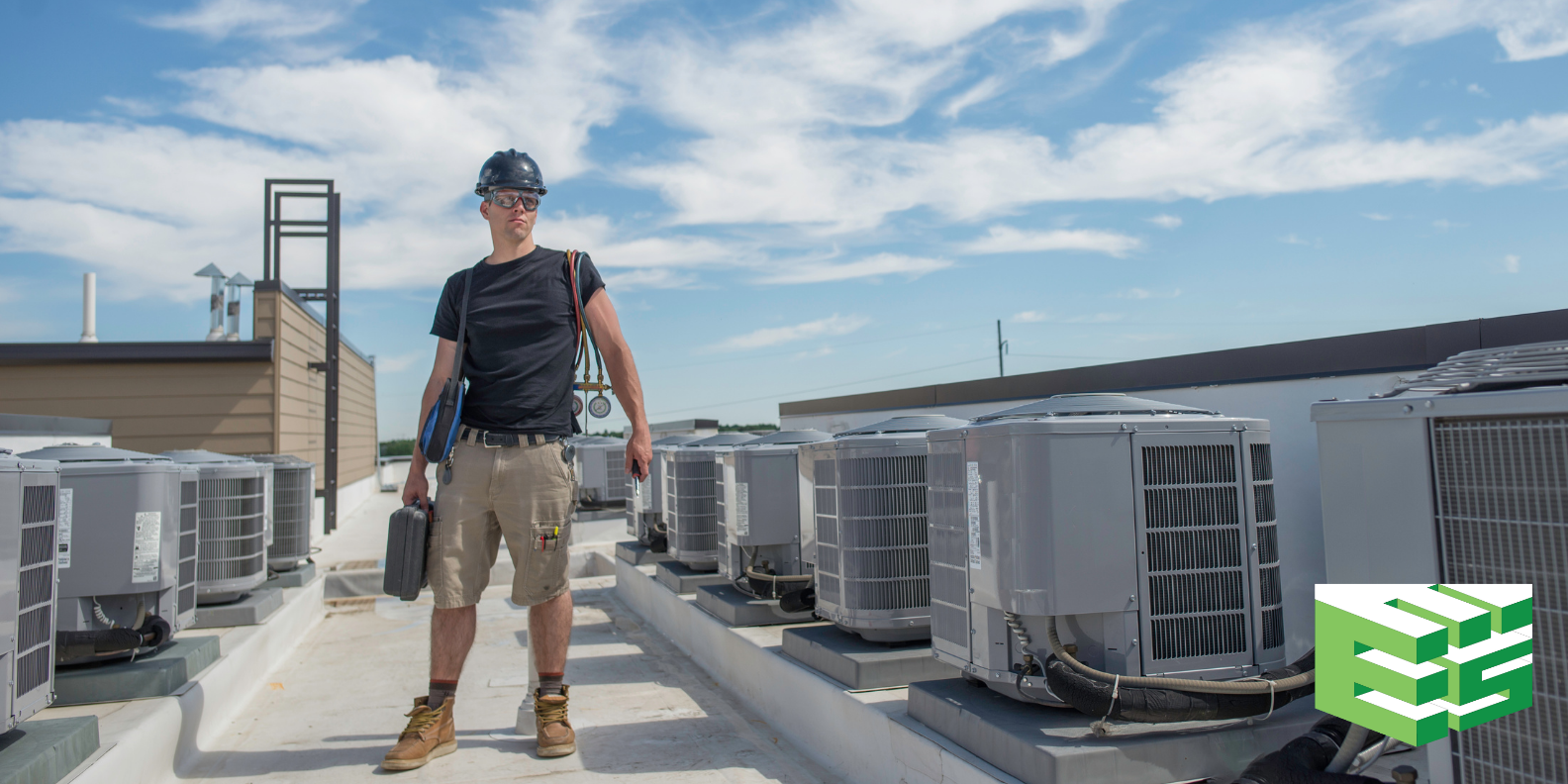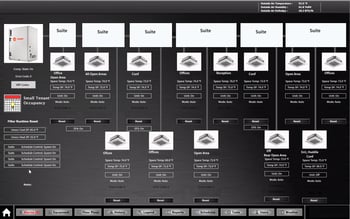
With the added control provided by a VRF system, there are many advantages over conventional air handling systems, including energy savings and a low total cost of ownership.
While variable refrigerant flow (VRF) systems were introduced nearly four decades ago, recent advancements in mechanical, electrical, and digital technologies have substantially enhanced their control capabilities for maximum operating efficiency. VRF systems have been the dominant HVAC system in Europe for many years and with the advancement in technology and a greater focus on green initiatives, VRF systems are gaining in popularity here in the U.S. VRF systems are slowly replacing conventional HVAC systems in multi-unit residential and light commercial applications.
VRF systems are typically used in both single-occupant and multi-room spaces, with no practical limit on space size. If one condenser system can’t handle the whole load, simply add another one. VRF capabilities include simultaneous heating and cooling as well as heat recovery. The VRF system is made up of an indoor air handler and a condenser which flows refrigerant through the system based on the heating or cooling needs of the space. VRF condenser units can either be air-cooled or water-cooled. Air-cooled units are located outside and resemble a home air conditioner condenser. Water-cooled units are usually located indoors in a larger building that has condenser water and a way to remove the heat. The air handler is located indoors and can be ceiling, wall, or closet mounted. EES installed and maintains more than 80 separate systems for tenants in one building which are all monitored and controlled with a central building management system (BMS).
VRF System Options
There are two basic styles of VRF systems, either with or without a mode selection option. If the system doesn’t have the mode selection option, all of the VRF units must operate in cooling or heating at the same time. The mode selection option adds the capability to operate some VRF units in heating and some in cooling, and this is where heat recovery can come into play. If one room is in cooling mode, the system is able to transfer the excess heat from the cooled room to heat a different room instead of transferring the heat back to the compressor to be released into the atmosphere, thereby saving energy.
VRF Compact Size
Another benefit of VRF systems is their compact size; they are much smaller than the mammoth air handlers commonly used in large commercial buildings. In traditional commercial HVAC design, massive air handlers are installed in the basement, each driving four or five floors. Additionally, rooftop cooling towers and other equipment are required, taking up valuable space. At a height of approximately five feet, VRF systems are much smaller, and they take only a fraction of the outdoor space required by traditional HVAC systems.
The Green Factor and VRF Zone Control
With today’s focus on the environment and green buildings, managers can be very granular in what they turn on, which is a lot more efficient in a time when half of the building may not be occupied, thereby reducing energy cost and carbon footprint. With their compact size, VRF systems can be located immediately outside of the conditioned space, freeing up interior and exterior building square footage for other uses.
VRF Health Benefits
Another positive aspect of VRFs, especially relating to the pandemic and personal health in general, is that these systems use recirculated air within each room, so there is no “shared air” throughout the residential areas of the building. To accommodate fresh air requirements, EES pumps fresh air in, which is ducted into each unit individually with a return to balance the pressure. Carbon dioxide levels are monitored, adding fresh air as required. For example, when a room is unoccupied, there is no carbon dioxide being produced so less fresh air is needed; as the occupancy increases, the system adjusts accordingly. In a recently completed project luxury oceanfront residential community Pier Village, EES designed a fresh air system which is separately ducted, conditioned, and circulated to each living space ensuring there is no shared air between residences.
VRF Total Cost of Ownership and Installation Advantages
Although the upfront design and installation costs of VRF systems may be equal to or higher than the cost of installing a conventional building HVAC system, the total cost of ownership for a VRF system is lower for several key reasons. With a VRF system, since the refrigerant is going directly into the conditioned space, there can be design constraints due to AHRAE safety codes limiting the amount of refrigerant that could potentially leak into the smallest conditioned space. This requirement limits the total amount of refrigerant allowed in the entire system, putting a practical limit on the size of a single unit. Again, if there is more load or square footage, add another unit. Another factor in the cost of a conventional HVAC system is the difficulty in placing interior and rooftop equipment, potentially with the use of costly cranes and rigging.
The compact VRF system provides relative ease of installation, normally being located immediately outside the space being conditioned and easily placed by installers without the use of heavy equipment. Although the main factor in their low total cost of ownership is energy efficiency, VRF systems do offer a huge advantage to building owners and managers over conventional systems in lower maintenance, repair, and utility costs. With conventional systems, building owners are responsible for the cost of maintaining and repairing the equipment, as well as paying the utility costs for the entire system. These systems cannot be individually metered, so utilities are instead apportioned. With VRFs, each unit owns its own system, and maintenance, repair and utilities are the occupant’s responsibility. Occupants pay the utilities and because of the individual metering, have control over utility costs.
Additional Considerations
Maintenance can be a bit more time consuming in VRF systems, as each system has its own filter that needs to be cleaned, as opposed to spending a few hours in a basement, in one place, cleaning the filters of a conventional system. Some of the newer VRF models feature HEPA filters that are integrated into the unit, allowing for better filtration and cleaner air than with older systems.
It takes experience to properly design and lay out VRF systems for maximum efficiency and effectiveness, especially when using the mode selection function. For example, in order to take advantage of energy recovery, there needs to be roughly the same number of zones that will always be in cooling as will need heating. In these situations, typically the external rooms that receive a heavy sun load need continual cooling, while the interior rooms need both heating and cooling, depending on the weather.
VRF Customization
In order to reach peak efficiency, VRF systems require customization by an experienced engineering team. Whether featuring mode selection or not, VRFs do not come from the factory with a night setback mode. According to the U.S. Department of Energy, it is estimated that a 1% energy savings can be achieved for every 1-degree setback for an 8-hour period. Night setback saves energy by turning the heat down at night or raising the temperature (if cooling) when spaces are unoccupied. As programmed from the factory, turning the heat down from 70 to 60 degrees on a VRF causes the system to go into cooling mode to lower the temperature from 70 to 60 degrees, as opposed to allowing it to naturally drift down to that temperature as a traditional system would. EES solves this problem by customizing the system to turn the unit off and monitor the temperature during a night setback. Once customized, if the heating night setback was from 70 to 60 degrees, the system would remain off and monitor the temperature. If the temperature went below 60 degrees, the system would turn back on in heating mode until the space reached 60 degrees. Additionally, EES customizes models that don’t have the mode-selector, allowing them to operate as cooling- or heating-only.
Because each conditioned space has different geometry and exposure, each building management system design and installation requires customization. EES has decades of experience with BMS design and installation, and can customize both new and existing systems to meet the dual needs of occupant comfort and energy efficiency. For more information, read this article on EES’ proprietary methodology PROCOS™.
Summary
For both residential and light commercial buildings, ‘green-building’ VRF systems will eventually replace conventional BMS systems due to their capabilities, cost-effectiveness, versatility, and smaller size. Please contact us to discuss a project or learn how your facility can lower operating and utility expenses.



